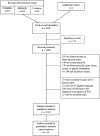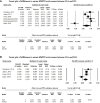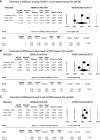Biomarkers in psoriatic arthritis: A meta-analysis and systematic review
- PMID: 36532039
- PMCID: PMC9749424
- DOI: 10.3389/fimmu.2022.1054539
Biomarkers in psoriatic arthritis: A meta-analysis and systematic review
Abstract
Introduction: Psoriatic arthritis (PsA) is a chronic inflammatory disease that frequently develops in patients with psoriasis (PsO) but can also occur spontaneously. As a result, PsA diagnosis and treatment is commonly delayed, or even missed outright due to the manifold of clinical presentations that patients often experience. This inevitably results in progressive articular damage to axial and peripheral joints and entheses. As such, patients with PsA frequently experience reduced expectancy and quality of life due to disability. More recently, research has aimed to improve PsA diagnosis and prognosis by identifying novel disease biomarkers.
Methods: Here, we conducted a systematic review of the published literature on candidate biomarkers for PsA diagnosis and prognosis in MEDLINE(Pubmed), EMBase and the Cochrane library with the goal to identify clinically applicable PsA biomarkers. Meta-analyses were performed when a diagnostic bone and cartilage turnover biomarker was reported in 2 or moredifferent cohorts of PsA and control.
Results: We identified 1444 publications and 124 studies met eligibility criteria. We highlighted bone and cartilage turnover biomarkers, genetic markers, and autoantibodies used for diagnostic purposes of PsA, as well as acute phase reactant markers and bone and cartilage turnover biomarkers for activity or prognostic severity purposes. Serum cartilage oligometrix metalloproteinase levels were significantly increased in the PsA sera compared to Healthy Control (HC) with a standardized mean difference (SMD) of 2.305 (95%CI 0.795-3.816, p=0.003) and compared to osteoarthritis (OA) with a SMD of 0.783 (95%CI 0.015-1.551, p=0.046). The pooled serum MMP-3 levels were significantly higher in PsA patients than in PsO patients with a SMD of 0.419 (95%CI 0.119-0.719; p=0.006), but no significant difference was highlighted when PsA were compared to HC. While we did not identify any new genetic biomarkers that would be useful in the diagnosis of PsA, recent data with autoantibodies appear to be promising in diagnosis, but no replication studies have been published.
Conclusion: In summary, no specific diagnostic biomarkers for PsA were identified and further studies are needed to assess the performance of potential biomarkers that can distinguish PsA from OA and other chronic inflammatory diseases.
Keywords: arthritis; meta-analysis; psoriasis; psoriatic arthritis; psoriatic biomarker.
Copyright © 2022 Wirth, Balandraud, Boyer, Lafforgue and Pham.
Conflict of interest statement
The authors declare that the research was conducted in the absence of any commercial or financial relationships that could be construed as a potential conflict of interest.
Figures





Similar articles
-
Serum bone-turnover biomarkers are associated with the occurrence of peripheral and axial arthritis in psoriatic disease: a prospective cross-sectional comparative study.Arthritis Res Ther. 2017 Sep 21;19(1):210. doi: 10.1186/s13075-017-1417-7. Arthritis Res Ther. 2017. PMID: 28934972 Free PMC article.
-
Broad proteomic screen reveals shared serum proteomic signature in patients with psoriatic arthritis and psoriasis without arthritis.Rheumatology (Oxford). 2021 Feb 1;60(2):751-761. doi: 10.1093/rheumatology/keaa405. Rheumatology (Oxford). 2021. PMID: 32793974 Free PMC article.
-
Anti-LL37 Antibodies Are Present in Psoriatic Arthritis (PsA) Patients: New Biomarkers in PsA.Front Immunol. 2018 Sep 12;9:1936. doi: 10.3389/fimmu.2018.01936. eCollection 2018. Front Immunol. 2018. PMID: 30279686 Free PMC article.
-
Biomarkers and prognostic stratification in psoriatic arthritis.Reumatismo. 2012 Jun 5;64(2):88-98. doi: 10.4081/reumatismo.2012.88. Reumatismo. 2012. PMID: 22690385 Review.
-
Systematic review and meta-analysis on prevalence of metabolic syndrome in psoriatic arthritis, rheumatoid arthritis and psoriasis.Int J Rheum Dis. 2021 Sep;24(9):1112-1120. doi: 10.1111/1756-185X.14147. Epub 2021 Jun 2. Int J Rheum Dis. 2021. PMID: 34076348
Cited by
-
Therapeutic potential of Coptis chinensis for arthritis with underlying mechanisms.Front Pharmacol. 2023 Aug 11;14:1243820. doi: 10.3389/fphar.2023.1243820. eCollection 2023. Front Pharmacol. 2023. PMID: 37637408 Free PMC article. Review.
-
The mediating role of key amino acid and vitamin metabolite ratios in the effects of 5 dietary habits on psoriatic arthritis: A Mendelian randomization study.Medicine (Baltimore). 2025 May 16;104(20):e42470. doi: 10.1097/MD.0000000000042470. Medicine (Baltimore). 2025. PMID: 40388781 Free PMC article.
-
Higher Synovial Immunohistochemistry Reactivity of IL-17A, Dkk1, and TGF-β1 in Patients with Early Psoriatic Arthritis and Rheumatoid Arthritis Could Predict the Use of Biologics.Biomedicines. 2024 Apr 8;12(4):815. doi: 10.3390/biomedicines12040815. Biomedicines. 2024. PMID: 38672170 Free PMC article.
-
Precision medicine using molecular-target drugs in psoriatic arthritis.Ther Adv Musculoskelet Dis. 2025 Jan 5;17:1759720X241311462. doi: 10.1177/1759720X241311462. eCollection 2025. Ther Adv Musculoskelet Dis. 2025. PMID: 39776828 Free PMC article. Review.
-
The Role of Osteopontin in Psoriasis-A Scoping Review.J Clin Med. 2024 Jan 23;13(3):655. doi: 10.3390/jcm13030655. J Clin Med. 2024. PMID: 38337350 Free PMC article.
References
Publication types
MeSH terms
Substances
LinkOut - more resources
Full Text Sources
Medical
Research Materials
Miscellaneous

